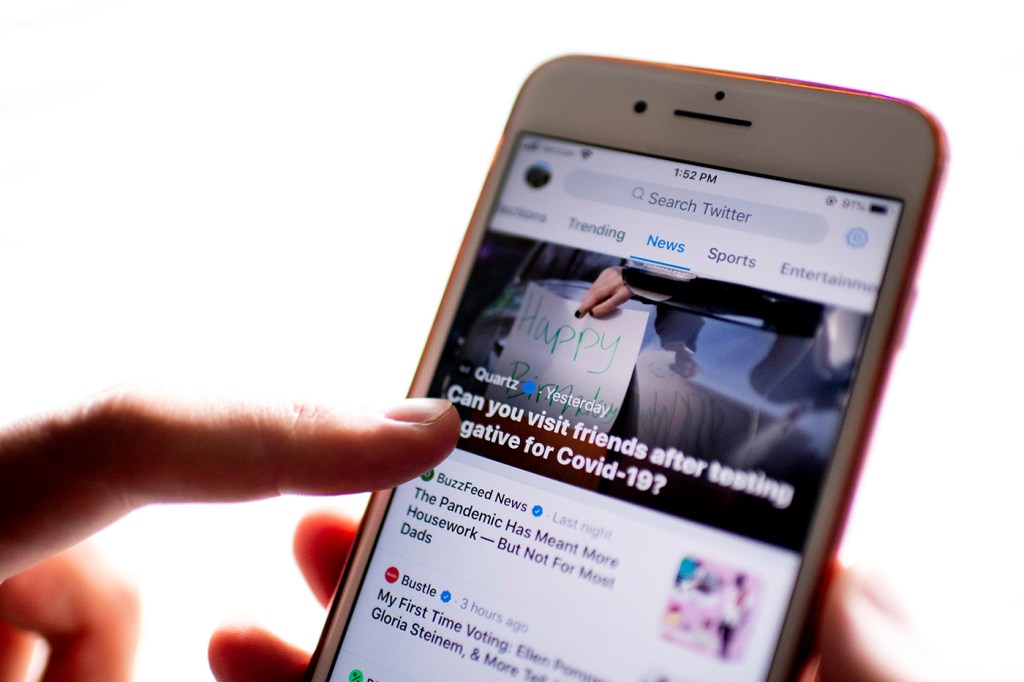The leading source of false claims about COVID-19? Hint: It’s not Facebook or Twitter.

Minorities and younger people are more susceptible to fake news and misinformation about COVID-19, and younger generations are also more likely to believe false claims they receive on closed messaging platforms such as WhatsApp and Facebook Messenger, according to a new national survey led by researchers from Northeastern, Harvard, Northwestern, and Rutgers universities.
The findings—released on Wednesday amid what scholars and public health officials have described as a “parallel epidemic of misinformation” around the COVID-19 pandemic—are the result of a study that gauged people’s acceptance of 11 false claims that have circulated online since the beginning of the crisis. It is the ninth in a series of surveys the researchers have been conducting since April examining attitudes and behaviors regarding the coronavirus crisis in the United States.
David Lazer, university distinguished professor of political science and computer and information sciences at Northeastern, and one of the researchers who conducted the study, says the findings suggest closed messaging applications could be a vector of misinformation.

David Lazer is university distinguished professor of political science and computer and information sciences at Northeastern. Photo by Adam Glanzman/Northeastern University
“Part of the interesting question about misinformation and misperceptions is which parts of the news information ecosystem are most vulnerable,” he says.
The researchers surveyed 21,196 residents across all 50 states and the District of Columbia between Aug. 7 and Aug. 26, and found that younger people, Republicans, men, and Black people are more susceptible to misinformation.
Participants were shown six false claims about conspiracies or risk factors and asked whether or not they thought each claim was accurate. They were also told of five fraudulent preventive treatments for COVID-19 and asked whether or not they believed the treatment was effective.
According to the report, 22 percent of participants said they believed the rumor that COVID-19 originated as a weapon in a Chinese lab, but less people (seven percent) trusted the claim that the flu vaccine increases the risk of contracting COVID-19.
While SARS-CoV-2, the virus that causes COVID-19, is among three coronaviruses that originate in bats, the exact source of the disease behind the pandemic is still unknown, according to the Centers for Disease Control and Protection.
Additionally, there is no evidence that getting a flu vaccine increases a person’s risk of getting sick with a coronavirus such as the one that causes COVID-19.
Other conspiracy theories believed by a segment of the participants included the statement that hand dryers prevent COVID-19 infections (17 percent), that only people over the age of 60 are at risk for COVID-19 (17 percent), that antibiotics can prevent COVID-19 (16 percent), and that humans were originally infected with COVID-19 by eating bats (16 percent), according to the report.
The latest scientific and public health information from the World Health Organization indicates that all of these claims are false.
The researchers also sought to evaluate the relationship between people’s belief in false claims and their willingness to get the COVID-19 vaccine once it becomes available. They found that people who believed the claims—especially the one about the virus originating in a Chinese laboratory—were less likely to seek the vaccine.
The survey found generational differences in misperceptions.
People under 25 held the highest misperceptions about COVID-19 while older people were less likely to believe the false claims. The rumor that COVID-19 was caused by human consumption of bats was most commonly believed by younger people, whereas only six percent of participants older than 64 believed it, the survey found.
“This is different from what we found in the past regarding older people,” says Lazer. “Other research indicates that older Americans are more likely to circulate misinformation. It could be that older people have more time to consume the news and maybe that they’re getting more misinformation, but they’re also getting more good information.”
The researchers found that younger people were more likely than their older counterparts to use mobile messaging and social media platforms for news about the pandemic. The eight percent of participants who reported getting news from Facebook Messenger on average said they believed 26 percent of the false claims they were shown. For those who reported getting their news from WhatsApp, the average likelihood of believing a false claim was 31 percent. The findings also show high levels of misperception among users of Snapchat, Instagram, and Wikipedia.
According to the report, there were less misperceptions among people who get their information about COVID-19 from cable news, with the exception of Fox News (viewers of the channel believed 18 percent of false claims).
Participants who indicated that they received news about the pandemic from local television news, news websites or apps, and community newspapers (11 percent in each case) recorded the lowest levels of misperceptions.
The survey also identified differences across racial and ethnic groups. Black people were the most likely (17 percent) to believe all of the 11 false claims, followed closely by Hispanic people (16 percent). However, these groups were also more likely than white people to express uncertainty about the accuracy of the claims.
Respondents were also stratified by political philosophies.
The study found that 16 percent of Republicans believed a given false claim, compared to 13 percent each for Democrats and independents. Thirty-five percent of Republicans believed the claim that COVID-19 originated in a Chinese lab, as opposed to only 14 percent of Democrats and 20 percent of independents.
Democrats were most likely to believe that the flu vaccine can prevent COVID-19 (17 percent, compared to 14 percent of Republicans and 12 percent of independents) and that the virus originated from the consumption of bats (also 17 percent, compared to 16 percent of Republicans and 14 percent of independents).
The three groups were equal in their belief that antibiotics are effective in preventing COVID-19.
Respondents’ willingness to believe false claims was split along gender identity as well.
Men were more likely than women to believe 10 of the 11 false claims: male participants had a 15 percent chance of believing a given false claim, compared to a 12 percent chance for female participants. The researchers attribute the differences in beliefs more to “male overconfidence” than evidence of gender gaps, according to the report.
“It is possible that the reason for this pattern is that men are simply more willing than women to express opinions, all else equal, due to overconfidence bias,” the researchers write.
Finally, the survey found that people who believed most of the false claims recorded a lower likelihood of following mask-wearing guidelines.
Peter Ramjug contributed to this report.
For media inquiries, please contact media@northeastern.edu.





